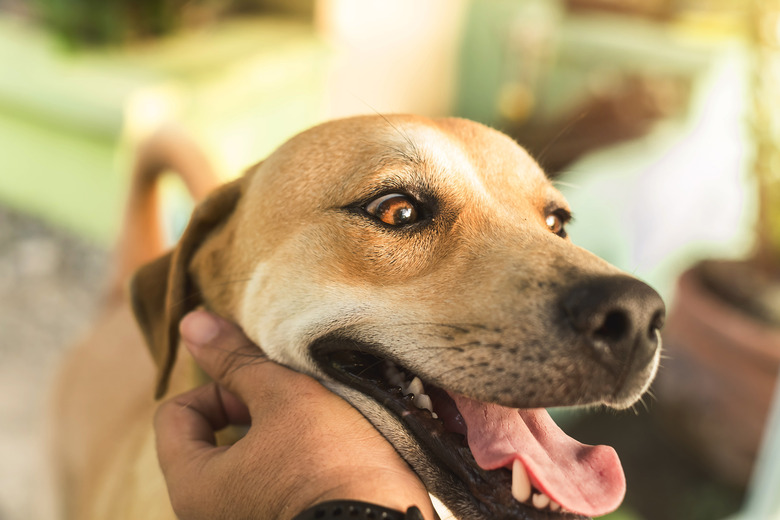Where Are A Dog's Pressure Points?
Where Are a Dog's Pressure Points?
For more than 3,000 years, people have practiced the ancient technique of acupressure — manipulating pressure points known as "acupoints" along the body. We spoke with Dr. Shagufta Mulla, a veterinarian with a DVM degree from Colorado State University with 20 years of experience as a small animal veterinarian, to learn more. "Acupressure is similar to acupuncture, but acupressure does not include the use of needles," says Dr. Mulla.
Much like humans, a dog's body is full of pressure points that lie along pathways called meridians, which, when properly stimulated, can help treat health conditions, assist with training, or even have a calming effect. "Meridians are the basis for Eastern healing methods, such as acupressure and acupuncture," says Dr. Mulla. Knowing where to locate pressure points and what behaviors or conditions they are attributed to can help you practice this holistic technique and possibly improve your dog's health.
Decrease a dog's anxiety with head and neck canine acupressure points
Decrease a dog's anxiety with head and neck canine acupressure points
Pressure points, thought to work by balancing the body's life force energy (the body's electrical energy, known as "chi"), are located throughout a dog's head. "According to traditional Chinese medicine, if chi flows freely through a being's meridians, they can remain healthy," says Dr. Mulla. "Meridians are very sensitive, and factors like stress, diet, and medication can reduce or block the flow of chi."
The pressure point known as gallbladder 20, or GB 20, is located on the back of a dog's head at the base skull. Properly massaging this spot can decrease a dog's nervousness and irritability and may improve sinus infections and reduce seizures. Governing vessel 26 (GV 26), the "revival point" located on the face where the hairless part of the nose meets the upper lip, has been used to treat respiratory arrest, sun stroke, or unconsciousness.
Improve a dog's stomach health with acupressure points on the back and spine
Improve a dog's stomach health with acupressure points on the back and spine
Several pressure points located along the sides of a dog's spine between the vertebrae can be manipulated to treat gastrointestinal or respiratory problems. "Points bladder 21 and 22, known as BL 21 and 22, are both located on the lower back on both sides of the spine," says Dr. Mulla. These can be used to reduce vomiting, improve stomach problems, and promote kidney health. Higher up along the spine between your dog's shoulder blades rests BL 13, bladder 13. Massaging this point could benefit a dog suffering from pneumonia and bronchitis.
Reduce a dog's pain with front and back leg acupressure points
Reduce a dog's pain with front and back leg acupressure points
Both a dog's front and hind legs contain multiple pressure points known to decrease pain and promote general health and wellness. On the back of the hind legs behind the knee sits BL 40, also called bladder 40. "This point is found in the center of the depression on the crease of the knee," says Dr. Mulla. It can reduce overall pain and stiffness. If your dog suffers from allergies or constipation, try manipulating LI 11, large intestine 11, located on the outside your dog's front legs at the elbow. "On the outside edge of the elbow crease," says Dr. Mulla.
Use master pressure points in paws and toes to restore balance
Use master pressure points in paws and toes to restore balance
Your dog's paws contain points, known as master pressure points, thought to restore the balance of energy to your dog's face, mouth, and shoulders. "The point large intestine 4, LI 4, is located in the web of the dewclaw or where the dewclaw would be," says Dr. Mulla. Massaging this point not only relieves pain but also increases a dog's overall immunity and immune system health. "It may also help with fever," says Dr. Mulla. When massaging this point, use gentle pressure with your index finger to start, as this point is extremely sensitive, and pressing too hard could cause your dog pain.
Choosing acupressure or veterinary care for your dog
Choosing acupressure or veterinary care for your dog
While it's useful to know how to perform it, acupressure for dogs or an acupressure session is not meant to replace routine veterinary care essential to your dog's health and well-being. Your dog's symptoms may be caused by an underlying health condition that requires medical attention. "Animal acupressure can mask clinical signs, thereby delaying diagnosis and appropriate treatment," points out Dr. Mulla. Also, it can be painful when you use acupressure incorrectly.
Visit a certified professional to learn more about the technique. "Veterinarians who are certified in canine acupuncture can perform these procedures at their office or assist you with at-home instructions," says Dr. Mulla. "Veterinarians can't call themselves 'specialists' unless they are board-certified in a specialty, which most veterinarians are not, including holistic veterinarians practicing acupuncture. Small animal veterinarians who aren't specialists can still be certified in canine acupuncture, so if you are interested in this form of holistic healing, seek out someone with the credential."
The bottom line
The bottom line
The ancient technique of acupressure can be used to improve general pet health, assist with training, or promote relaxation. Acupressure can be applied to a dog's head and neck, back and spine, legs, paws, and toes. Do not replace routine care from your DVM with acupressure, however, as your dog's symptoms may require medical attention. Many dogs enjoy forms of canine massage, so this practice could help you bond with your pet.


